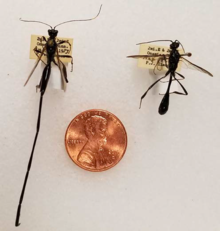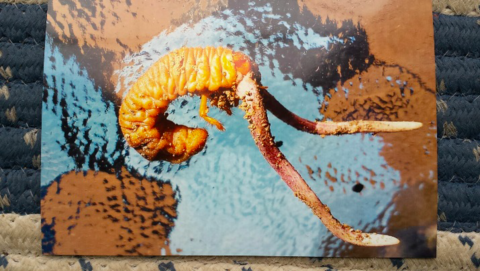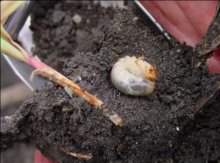The larvae of many scarab beetle species are often collectively referred to as white grubs – Phyllophaga, several species (spp.); Coleoptera: Scarabaeidae – and can be found in soil, decaying wood and manure.
In Minnesota, larvae of the genus Phyllophaga (Harris, Figure 1) are the scarabs most often associated with damage to corn root systems. These are the true white grubs. The adults (Figure 2) are the common May beetles, also known as June beetles and June bugs.
The University of Minnesota insect collection currently contains 18 species of Phyllophaga collected from various Minnesota geographies and habitats. These species can prefer different adult hosts and larval habitats. Crop-damaging infestations often consist of a single species but populations of mixed species have been reported.
Phyllophaga implicita (Horn) is one of the species most commonly encountered in Minnesota corn, often found in areas with sandy loam or loam soils and nearby cottonwood and willow trees. Other Phyllophaga species that have been implicated in damage to Minnesota corn include:
-
P. anxia (LeConte).
-
P. fusca (Froelich).
-
P. futilis (LeConte).
-
P. rugosa (Melsheimer).
-
P. nitida (LeConte).
-
P. drakei (Kirby).
Characteristics
True white grub larvae are found in the soil. The head and three pairs of legs are prominent on the fleshy C-shaped white grubs. Strong chewing mandibles and other mouthparts are readily visible on larger larvae. A portion of the upper rear abdomen is transparent with visible dark gut contents.
A zipper-like arrangement of spines, or raster, is present on the lower rear of the abdomen (Figure 3) and visible under magnification. The raster pattern can separate the true white grubs from other soil dwelling scarabs, including the annual white grubs, manure grubs and Japanese beetles.
The May beetles are robust, dark-reddish-brown beetles, 5/8- to 3/4-inch long. Their bulky bodies, long, slender legs and flattened front tibia modified for digging make them clumsy walkers. The fan-like lamellate antennae tips are flattened and layered; this antenna type is characteristic of the scarab family of beetles.
May beetles are active at night and attracted to lights. Relatively weak fliers, they often move with the wind when locating areas to lay eggs.
Life cycle
Like all beetles, true white grubs undergo complete metamorphosis. The insects progress through the egg, several immature (larva) stages, and a non-feeding intermediate (pupa) stage to the adult stage. As it grows, the larva must shed its exoskeleton (molt) between each of three distinct larval stages or instars (Figures 4 and 11).
The same process occurs as the insect transitions to the pupa and adult stage. The bodies of white grubs grow considerably between each molt. Meanwhile, the width of the larva’s head remains constant between each molt and can be used to determine the instar (Figure 11).
The typical life cycle for the white grubs attacking corn takes three years, but cycles of two and, more rarely, four years have also been reported.
Differences in duration possibly relate to soil temperatures during larval development. Although similar, there are some doubtless life cycle differences among Phyllophaga species. The discussion in the following paragraphs is generalized.
First year
As soils warm to the upper 50s in the spring, the overwintered adult emerges from the soil. Beetle emergence occurs during the evening in May and early June, hence the common name. If you happen to be in the right place and time on a quiet spring evening, a low-pitched buzz can indicate a May beetle is taking wing nearby.
At dusk, May beetles seek out nearby food plants – in most cases deciduous trees – where they feed on leaves. Males seeking mates are assisted by pheromones produced by females. At dawn, females return to nearby soils seeking sites with suitable soil texture and moisture content, burrowing into the soil to deposit clusters of eggs.
Larvae hatch the same summer. They feed on organic matter and find the roots of numerous plants, including corn, suitable hosts. During this first summer, the larvae feed and molt from the first to second instar. This first year of feeding doesn’t cause significant crop injury.
White grubs can’t tolerate freezing temperatures. When temperatures cool in the fall, larvae migrate lower in the soil, below the normal frost line, to survive winter.
Second year
The next spring, larvae migrate upward to feed, typically in the upper 3 to 4 inches of soil. Aggressive feeding on the roots of young plants poses the greatest risk for economic crop damage. The potential for damage increases when larvae reach surface soils early with respect to corn root development.
During this second year, the second instar larvae molt to third instar by mid-summer. As fall soils cool, white grubs once again move lower in the soil profile to overwinter.
Third year
In the third spring, third instar white grubs return to the upper soil layer to feed. Feeding by these maturing, third-year grubs is less aggressive and seldom results in economic damage.
The mature larvae create a pupal cell in the soil where, by late summer, they molt to the pupa. Adults subsequently emerge from the pupa, with the beetles remaining below ground, in the pupal cell, until the following spring.
Multiple generations
There can be overlapping generations in a field but not all are equally abundant.
Within a species and geographic region, one brood in the three-year cycle tends to dominate in a region and its larvae are the ones producing significant stand losses during their second spring. Often, the dominant brood and its resulting feeding damage can be predicted and more efficiently monitored and managed.
Annual grubs
Other white grubs that might be found feeding on, or associated with, corn roots in Minnesota include several species with annual life cycles:
-
Annual white grubs,Cyclocephala species (sp.)
-
Japanese beetles, Popillia japonica (Newman).
-
The small, non-damaging manure grubs, Aphodius spp. (Figure 5).
Unlike the true white grubs, these species have single-year life cycles.
Predicting damage potential
Knowing what type of grub is present in the field, its life cycle and the life-stage of the grubs are all helpful in predicting the damage potential the following year.
Where they live
The larvae of numerous Scarab beetle species are known as crop pests worldwide.
Phyllophaga is a scarab genus native to the New World. There are more than 200 Phyllophaga species native and endemic to various parts of the United States and Canada, relatively few of these are known crop pests.
May beetles primarily feed on leaves. Some species, including P. implicita, prefer cottonwood, willows, ash and maple trees.
The grubs feed on the root systems of many plants including corn, cereals, soybean, potato, vegetable crops, nursery stock, turf, pasture Conservation Reserve Program (CRP) plantings and other perennial grasses. Sod-forming grass stands are preferred egg-laying sites for some Phyllophaga species.
Natural enemies
The larvae have numerous natural enemies including birds, small mammals, and other insects.
Birds are the primary predators of emerged May beetles but some predation by other insects also occurs.
Spiders, mites, predatory or parasitic beetles, wasps and flies have been documented as larval enemies.
The shiny, black, female Pelecinid wasp (Hymenoptera: Pelecinidae), uses her long abdomen to insert eggs into grubs deep in the soil (Figure 6).
Milky spore disease, caused by the bacteria, Paenebacillus popilliae, was first identified in Japanese beetle larvae. Milky spore can infect the larvae of Phyllophaga species but other bacteria are likely more important.
The ascomycete fungus, Cordyceps sp., produces long, horn-like reproductive structures from the heads of white grubs that it has infected, killed and mummified (Figure 7). Other fungal, bacterial and nematode entomopathogens (insect diseases) produce equally deadly but less dramatic symptoms (Figure 8).
Damage symptoms and characteristics
During rare, extreme outbreaks, the feeding of May beetles is known to defoliate deciduous trees. More typically, the beetles don’t cause significant damage to trees. Plus, unlike Japanese beetles, the adults of true white grubs don’t injure corn or soybean crops.
Historically, localized, severe outbreak infestations of Phyllophaga, or true white grubs, have occurred in Midwestern states, including areas of Minnesota.
The larval stage damages crops. White grubs use their strong chewing mouthparts to feed on the root hairs and lateral roots of grasses, corn, soybeans and other crops (Figure 9).
White grub damage usually occurs in patches within a field because of the female’s elevation and soil type preferences.
Additionally, egg-laying and the subsequent larval damage is often concentrated a short distance (within 300 feet) from individual trees or tree lines from the trees where adults feed. However, in some cases, egg laying and larval damage has been observed at some distance from trees.
Corn, and other crops, planted after CRP and other sod are considered at higher risk for damage from species of true white grub. The presence of weeds or other non-crop root biomass within a field may reduce feeding injury to crop roots.
Economic injury from first year larvae seldom occurs. Most crop damage occurs during the second year of the three-year life cycle.
A lack of root hairs and pruned lateral roots characterize white grub feeding. This injury may reduce the corn stand if the mesocotyl is destroyed before nodal roots can develop or when root pruning is severe enough to prevent water and nutrient uptake. The belowground damage to small lateral roots can go unnoticed until the nutrient and water demands of growing corn plants increase.
Aboveground symptoms on corn and other plants resemble drought-induced wilting or a nutrient deficiency. These symptoms can easily be confused with moisture stress during the early stages of corn decline, particularly in the lighter soils where infestations most often occur.
Scouting
Scout for white grub as part of spring stand evaluations and post-emergence weed-control scouting.
Watch for feeding activity by seagulls and other birds during spring tillage as an indicator of white grub infestations.
Skunks and other small mammals love to feed on white grubs. When scouting missing stands, the signs of digging around the missing plants by tiny, skunk-sized feet are a very good indicator of the presence of white grubs (Figure 10).
In fields with a history of white grub infestations, late summer soil samples can determine the larval instars present and their density. Within 300 feet of groups of trees or tree lines, take 1-square-foot soil samples six inches deep and look for larvae.
All larval instars, pupae and adults are often found in the same field. Don’t count adults and pupae in your sample; they won’t injure the next year’s crop.
The bodies of white grubs grow considerably between each molt. The width of the larva’s head, on the other hand, remains constant between each molt and can be used to determine the instar (Figure 11).
Time-saving sequential sampling thresholds have been developed for white grubs. A first and second instar larval population greater than one per square foot is typically used as an action threshold to trigger management the following season.
A late-summer sample, taken to a shallow depth in the soil, can predict potential economic damage in the following year’s crop, while providing the maximum lead time for management decisions.
Managing grub infestations
There are no rescue treatments labeled for economic white grub infestations. Replanting damaged areas of a cornfield is an economical option only when infestations are found early. When considering replanting thinned stands, balance planting date with stand reduction.
Cases of economic damage are relatively rare and, when they occur, are often spotty within infested fields. This is why, in general, insurance insecticide applications aren’t likely to provide economic benefit.
Several factors can increase the risk of economic loss from true white grub infestations. Corn planted into fields that have recently been pasture, CRP or other sod situations, often see high populations of true white grubs. These types of fields have a higher probability of economically benefiting from an insecticide application.
Some fields experience recurring white grub problems. They often have a suitable combination of vegetation (trees) suitable for adult congregation and feeding, and soil factors suitable for egg-laying and larval survival.
Corn seedlings whose growth is slowed by cool weather or other environmental factors can be more vulnerable to stand loss. Potentially, reduced tillage may favor white grubs by improving larval survival or by increasing attractiveness to egg-laying beetles.
The neonicotinoid (e.g., clothianidin, thiamethoxam, imidacloprid) insecticide seed treatments typically provided with hybrid corn seed can provide control or suppression of white grubs. For high-risk situations and replants, high rates of labeled neonicotinoid insecticide seed treatments, at-plant granular corn rootworm insecticides and in-furrow liquid insecticides provide control of white grubs (Figure 12).
Insecticide resistance hasn’t been documented in true white grub. However, even when an insecticide is used, feeding on the periphery of root systems is still possible when white grubs are very numerous or they begin feeding on crop root systems late in the spring.
Since the early 2000s, the widespread use of seed-applied insecticides and increased use of at-plant rootworm insecticides has likely minimized economic white grub infestations in corn.
Removing shelterbelts has reduced beetle feeding and mating sites in proximity to crop fields. Nonetheless, yield-limiting true white grub infestations in corn and other crops still occasionally occur.
Products are mentioned for illustrative purposes only. Their inclusion doesn’t imply endorsement, nor does their absence imply disapproval.
Always read and follow the pesticide label.
Davis, J.J. Common white grubs. (1913). Farmers’ bulletin (143). United States Department of Agriculture, pp. 20.
Davis, J.J. (1919). Contributions to a knowledge of the natural enemies of Phyllophaga. State of Illinois Bulletin of the Natural History Survey XII (V).
Dahl, R.A. & Mahr, D.L. (1991). Light Trap Records of Phyllophaga (Coleoptera: Scarabaeidae) in Wisconsin,1984-1987. The Great Lakes Entomologist, 24(1), 1-8.
Dingman, D.W. (2008). Geographical distribution of milky disease bacteria in the eastern United States based on phylogeny. Journal of Invertebrate Pathology, 97(2), 171-181.
Flanders, K.L., Heinrichs, E.A., Foster, J.E., & Rice, M.E. (2009). Maize pests of North America. In: E.B. Radcliffe, W.D. Hutchison & R.E. Cancelado (Eds.) Radcliff’s IPM world textbook. St. Paul, MN: University of Minnesota.
Glogoza, P.A., Weiss, M.J., & Rao, M.B. (1998). Spatial distribution of Phyllophaga implicita (Horn) (Coleoptera: Scarabaeidae) larvae in relation to distance from the adult food source. Journal of Economic Entomology, 91(2), 457-463.
Guppy, J.C., & Harcourt, D.G. (1973). A sampling plan for studies on the population dynamics of white grubs, Phyllophaga spp. (Coleoptera: Scarabaeidae). Canadian Entomologist, 105(3), 479-483.
Guppy, J.C. (1982). Effects of temperature and light intensity on nocturnal activity patterns of the northern June beetle, Phyllophaga fusca, and the common June beetle, P. anxia (Coleoptera: Scarabaeidae). Canadian Entomologist, 114(12), 1151-1157.
Ives, W.G.H., & Warren, G.L. (1965). Sequential sampling for white grubs. Canadian Entomologist 97(6), 596-604.
Jackson, T.A., & Klein, M.G. (2006). Scarabs as pests: A continuing problem. Coleopterists Society Monograph, 60(5),102-119.
Jordan, T.A., Youngman, R.R., Laub, C.L., Tiwari, S., Kuhar, T.P., Balderson, T.K., Moore, D.M., & Saphir, M. (2012). Fall soil sampling method for predicting spring infestation of white grubs (Coleoptera: Scarabaeidae) in corn and the benefits of clothianidin seed treatment in Virginia. Crop Protection, 39, 57-62.
Katovich, K., Levine, S.J., & Young, D.K. (1998). Characterization and usefulness of soil-habitat preferences in identification of Phyllophaga (Coleoptera: Scarabaeidae) larvae. Annals of the Entomological Society of America, 91(3), 288-297.
Lentz, G.L. (1985). Occurrence of Phyllophaga congrua (LeConte) and P. implicita (Horn) (Coleoptera: Scarabaeidae) on soybeans. Journal of the Kansas Entomological Society, 58(2), 202-206.
Luginbill, P. & Painter, H.R. (1953). May beetles of the United States and Canada. U.S. Department of Agriculture Technical Bulletin (No. 1060), pp. 102.
Luhman, J. (2015). Diagnostic key to common Minnesota Phyllophaga (Scarabaeidae, melolonthinae). Unpublished.
Martinez-Hernandez, A., Alatorre-Rosas, R., Guzman-Franco, A.W., & Rodriguez-Leyva, E. (2015). Effect of dual inoculation with nematodes and fungal pathogens on the survival of Phyllophaga polyphylla larvae (Coleoptera: Scarabaeidae). Biocontrol Science and Technology, 25(11), 1,221-1,232.
Poprawski, T.J. & Yule, W.N. (1991). Incidence of fungi in natural populations of Phyllophaga spp. and susceptibility of Phyllophaga anxia (LeConte) (Col., Scarabaeidae) to Beauveria bassiana and Metarhizium anisopliae (Deuteromycotina). Journal of Applied Entomology, 112, 359-365.
Rice, M.E. (1994). Damage assessment of the annual white grub, Cyclocephala lurida (Coleoptera: Scarabaeidae) in corn and soybean. Journal of Economic Entomology, 87, 220-222.
Rivers, R.L., Pike, K.S., & Mayo, Z.B. (1977). Influence of insecticides and corn tillage systems on larval control of Phyllophaga anxia. Journal of Economic Entomology, 70(6), 794-796.
Robbins P.S., Alm, S.R., Armstrong C.D., et al. (2006). Trapping Phyllophaga spp. (Coleoptera: Scarabaeidae: Melolonthinae) with sex attractants in the United States and Canada. Journal of Insect Science, 6(39):1-124.
Sweetman, H.L. (1927). Preliminary report on the factors controlling oviposition of May beetles in Minnesota. Journal of Economic Entomology, 20, 783-794
Sweetman, H.L. (1931). Preliminary report on the physical ecology of certain Phyllohaga (Scarabaeidae: Coleoptera). Ecology, 12(2), 401-422.
Teetes, G.L. (1973). Phyllophaga crinita: damage assessment and control in grain sorghum and wheat. Journal of Economic Entomology, 66(3), 773-776.
Teetes, G.L., & Sterling, W.L. (1976). A sequential sampling plan for a white grub in grain sorghum. Southwestern Entomologist, 1(3), 118-121.
Reviewed in 2021













